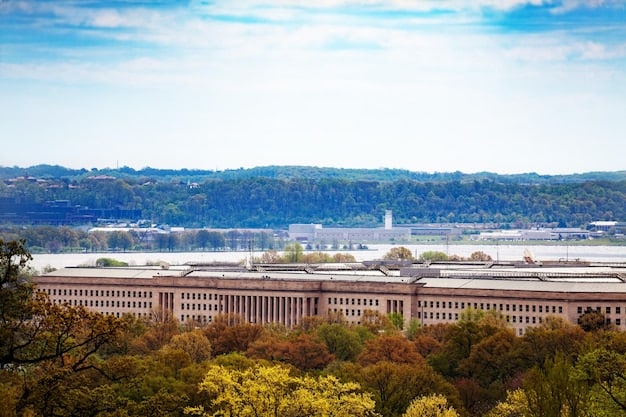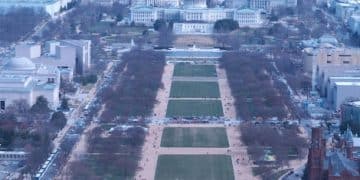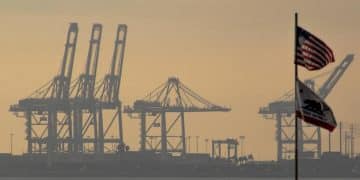Understanding the Federal Reserve’s Role in Managing the US Economy

Understanding the Role of the Federal Reserve in Managing the Economy: A Guide to Monetary Policy explores how the Fed influences economic stability and growth through tools like interest rates, reserve requirements, and open market operations, aiming to maintain price stability and full employment in the US.
The Federal Reserve plays a crucial role in shaping the economic landscape of the United States. Understanding the Role of the Federal Reserve in Managing the Economy: A Guide to Monetary Policy is essential for anyone looking to grasp how this institution impacts everything from interest rates to employment levels.
What is the Federal Reserve?
The Federal Reserve, often referred to as the Fed, is the central banking system of the United States. Understanding its structure and purpose is foundational to grasping its role in economic management.
Established by Congress in 1913, the Federal Reserve Act created a system designed to prevent the financial panics that had plagued the nation. It’s not directly part of the government, but operates independently within it.
Structure of the Federal Reserve
The Federal Reserve System is composed of several key entities working together. These include the Board of Governors, the 12 Federal Reserve Banks, and the Federal Open Market Committee (FOMC).
- The Board of Governors, based in Washington, D.C., consists of seven members appointed by the President of the United States and confirmed by the Senate.
- The 12 Federal Reserve Banks are located in major cities across the country and serve their respective districts.
- The FOMC is responsible for setting monetary policy, including the federal funds rate.
The Federal Reserve’s structure allows for both centralized decision-making and regional input, intended to balance national economic goals with local economic conditions.

Monetary Policy Tools
The Federal Reserve employs a variety of tools to influence the economy. These tools are collectively known as monetary policy, and they are crucial for maintaining economic stability.
These tools include setting the federal funds rate, adjusting reserve requirements for banks, and conducting open market operations. Each tool has a different impact on the economy, and the Fed uses them in combination to achieve its goals.
The Federal Funds Rate
The federal funds rate is the target rate that the FOMC wants banks to charge one another for the overnight lending of reserves. This rate influences other interest rates throughout the economy.
When the Fed lowers the federal funds rate, it becomes cheaper for banks to borrow money, which can stimulate economic activity by encouraging lending and investment. Conversely, raising the rate can slow down the economy.
Reserve Requirements
Reserve requirements are the fraction of a bank’s deposits they are required to keep in their account at the Fed or as vault cash. Changes to these requirements can impact the amount of money banks have available to lend.
- Lowering reserve requirements increases the amount of money banks can lend, stimulating economic growth.
- Raising reserve requirements decreases the amount of money banks can lend, slowing down economic growth.
Open Market Operations
Open market operations involve the buying and selling of U.S. government securities by the Federal Reserve. This is the Fed’s most frequently used tool in implementing monetary policy.
When the Fed buys securities, it injects money into the banking system, increasing the money supply and lowering interest rates. When it sells securities, it removes money from the banking system, decreasing the money supply and raising interest rates.
The Fed uses these tools to influence economic conditions by controlling the availability of money and credit in the economy.
Goals of Monetary Policy
The Federal Reserve has two primary goals when conducting monetary policy: price stability and maximum employment. These goals are often referred to as the “dual mandate.”
Achieving these goals requires careful consideration of economic conditions and the potential impacts of monetary policy decisions.
Price Stability
Price stability means keeping inflation at a low and stable level. The Fed typically targets an inflation rate of 2% per year.
High inflation can erode purchasing power and create economic uncertainty, while deflation can discourage spending and investment. The Fed aims to keep inflation within its target range to promote economic stability.
Maximum Employment
Maximum employment means keeping the unemployment rate as low as possible without causing excessive inflation. This level is not necessarily zero, as some level of unemployment is natural in a dynamic economy.
- The Fed considers a range of factors when assessing the labor market, including job creation, wage growth, and labor force participation.
- Achieving maximum employment requires balancing the need to stimulate job growth with the risks of inflation.
The dual mandate reflects the Fed’s commitment to promoting both stable prices and a healthy labor market.
The Fed’s Role in Economic Crises
The Federal Reserve plays a critical role in responding to economic crises. During times of financial stress, the Fed can act as a lender of last resort, providing liquidity to banks and other financial institutions.
The Fed’s actions during the 2008 financial crisis and the COVID-19 pandemic demonstrate its ability to stabilize the financial system and support the economy during times of turmoil.

The 2008 Financial Crisis
During the 2008 financial crisis, the Fed took unprecedented actions to prevent a collapse of the financial system. These actions included lowering interest rates to near zero and providing emergency loans to banks and other institutions.
The Fed’s interventions helped to stabilize the financial system and prevent a deeper recession, but they also sparked controversy and debate about the appropriate role of the central bank.
The COVID-19 Pandemic
In response to the COVID-19 pandemic, the Fed again took swift and decisive action to support the economy. These actions included lowering interest rates to zero, purchasing trillions of dollars in government bonds and mortgage-backed securities, and establishing new lending facilities to support businesses and households.
- These measures helped to cushion the economic blow from the pandemic and support the recovery.
- The Fed’s response also raised concerns about the potential for inflation and asset bubbles.
The Fed’s role in economic crises highlights its importance as a stabilizer of the financial system and a supporter of the economy during times of stress.
Criticisms and Challenges
The Federal Reserve has faced numerous criticisms and challenges over the years. These criticisms often focus on the Fed’s independence, its impact on income inequality, and its ability to effectively manage the economy.
Addressing these criticisms and challenges is essential for maintaining the Fed’s credibility and effectiveness.
Independence of the Federal Reserve
Some critics argue that the Fed is too independent from political control and that its decisions are not sufficiently accountable to the public. They argue that the Fed’s independence allows it to pursue policies that may not be in the best interests of the country.
- Proponents of Fed independence argue that it is necessary to insulate monetary policy from short-term political pressures.
- They argue that independent central banks are better able to maintain price stability and promote long-term economic growth.
Impact on Income Inequality
Some critics argue that the Fed’s policies disproportionately benefit the wealthy and exacerbate income inequality. For example, low interest rates can boost asset prices, benefiting those who own stocks and real estate.
The Fed acknowledges that its policies can have distributional effects and that it needs to be mindful of these effects when making decisions.
Effectiveness of Monetary Policy
Some critics question the Fed’s ability to effectively manage the economy. They argue that monetary policy is a blunt instrument that can have unintended consequences and that it is not always effective in addressing economic problems.
The Fed continuously evaluates the effectiveness of its policies and adapts them as needed in response to changing economic conditions.
Understanding the criticisms and challenges facing the Federal Reserve is essential for evaluating its role in managing the economy.
The Future of Monetary Policy
The future of monetary policy is likely to be shaped by a number of factors, including technological innovation, globalization, and demographic change. The Federal Reserve will need to adapt its policies and strategies to address these challenges.
As economies evolve, central banking must as well. Keeping ahead of potential issues and being prepared is key.
Technological Innovation
Technological innovation is transforming the financial system and creating new challenges for monetary policy. For example, the rise of cryptocurrencies and other digital assets could potentially disrupt the traditional banking system and challenge the Fed’s control over the money supply.
- The Fed is actively researching digital currencies and exploring the potential implications for monetary policy.
Globalization
Globalization has increased the interconnectedness of the world economy and made it more difficult for central banks to control inflation and maintain financial stability. The Fed needs to coordinate its policies with other central banks to address global economic challenges.
Demographic Change
Demographic change, such as the aging of the population in many countries, is also creating new challenges for monetary policy. For example, an aging population may lead to lower interest rates and slower economic growth.
The Fed needs to consider these demographic trends when setting monetary policy and planning for the future.
The future of monetary policy will require the Federal Reserve to be adaptable, innovative, and forward-looking.
| Key Point | Brief Description |
|---|---|
| 🏦 Federal Reserve | US central bank managing monetary policy. |
| 🎯 Dual Mandate | Price stability and maximum employment goals. |
| 📉 Interest Rates | Tool to stimulate or slow down economic activity. |
| 🛡️ Economic Crises | Acts as lender of last resort to stabilize economy. |
Frequently Asked Questions
▼
The Federal Reserve’s main role is to manage the nation’s monetary policy to promote maximum employment and stable prices in the U.S. economy.
▼
The Fed controls inflation primarily by adjusting the federal funds rate, which influences interest rates throughout the economy, thus affecting borrowing and spending.
▼
Open market operations involve the Federal Reserve buying or selling U.S. government securities to influence the money supply and credit conditions in the economy.
▼
The Fed’s independence is designed to insulate monetary policy decisions from short-term political pressures, allowing it to focus on long-term economic stability.
▼
The discount rate is the interest rate at which commercial banks can borrow money directly from the Fed, serving as another tool to influence lending and economic activity.
Conclusion
Understanding the Federal Reserve’s role in managing the economy is vital for informed citizenship. By using monetary policy tools, the Fed strives to maintain price stability and maximum employment, contributing to the overall health and stability of the U.S. economy. The Fed’s actions directly influence the financial well-being of individuals and businesses alike.





